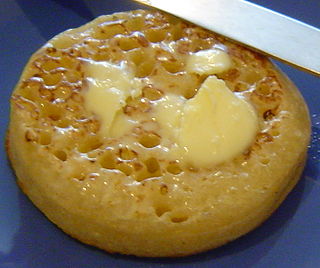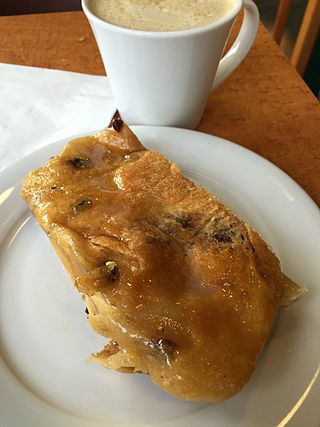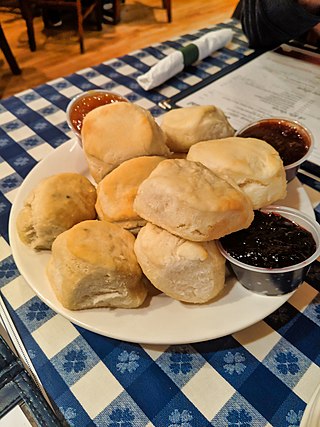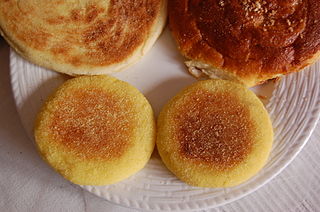
Bread is a staple food prepared from a dough of flour and water, usually by baking. Throughout recorded history and around the world, it has been an important part of many cultures' diet. It is one of the oldest human-made foods, having been of significance since the dawn of agriculture, and plays an essential role in both religious rituals and secular culture.

Pastry is baked food made with a dough of flour, water, and shortening that may be savoury or sweetened. Sweetened pastries are often described as bakers' confectionery. The word "pastries" suggests many kinds of baked products made from ingredients such as flour, sugar, milk, butter, shortening, baking powder, and eggs. Small tarts and other sweet baked products are called pastries as a synecdoche. Common pastry dishes include pies, tarts, quiches, croissants, and pasties.

A muffin is an individually portioned baked product; however, the term can refer to one of two distinct items: a part-raised flatbread that is baked and then cooked on a griddle, or a quickbread that is chemically leavened and then baked in a mold. While quickbread "American" muffins are often sweetened, there are savory varieties made with ingredients such as corn and cheese, and less sweet varieties like traditional bran muffins. The flatbread "English" variety is of British or other European derivation, and dates from at least the early 18th century, while the quickbread originated in North America during the 19th century. Both types are common worldwide today.

A crumpet is a small griddle bread made from an unsweetened batter of water or milk, flour, and yeast, popular in the United Kingdom, Canada, New Zealand, South Africa and Australia.

Potato bread is a form of bread in which potato flour or potato replaces a portion of the regular wheat flour. It is cooked in a variety of ways, including baking it on a hot griddle or pan, or in an oven. It may be leavened or unleavened, and may have a variety of other ingredients baked into it. The ratio of potato to wheat flour varies significantly from recipe to recipe, with some recipes having a majority of potato, and others having a majority of wheat flour. Some recipes call for mashed potatoes, with others calling for dehydrated potato flakes. It is available as a commercial product in many countries, with similar variations in ingredients, cooking methods, and other variables.

Parkin is a gingerbread cake traditionally made with oatmeal and black treacle, which originated in Northern England. Often associated with Yorkshire, it is widespread and popular elsewhere, notably in Lancashire. Parkin is baked to a hard cake but with resting becomes moist and even sometimes sticky. There are regional differences, for example in Hull and East Yorkshire, it has a drier, more biscuit-like texture than in other areas whereas in Lancashire it is generally made with golden syrup rather than the treacle used elsewhere. Parkin is traditionally eaten on Guy Fawkes Night, 5 November, and when celebrating 'Yorkshire Day' on 1 August. But is also enjoyed throughout the winter months. It is baked commercially throughout Yorkshire, but is mainly a domestic product in other areas.

Indian breads are a wide variety of flatbreads and crêpes which are an integral part of Indian cuisine. Their variation reflects the diversity of Indian culture and food habits.

Johnnycake, also known as journey cake, johnny bread, hoecake, shawnee cake or spider cornbread, is a cornmeal flatbread, a type of batter bread. An early American staple food, it is prepared on the Atlantic coast from Newfoundland to Jamaica. The food originates from the indigenous people of North America. It is still eaten in the Bahamas, Belize, Bermuda, Canada, Colombia, Curaçao, Dominican Republic, Jamaica, Puerto Rico, Saint Croix, and the United States.

Lardy cake, also known as lardy bread, lardy Johns, dough cake and fourses cake, is a traditional rich spiced form of bread found in several southern counties of England, each claiming to provide the original recipe. It remains a popular weekend tea cake in the southern counties of England, including Sussex, Surrey, Hampshire, Berkshire, Wiltshire, Dorset and Gloucestershire.

Vienna bread is a type of bread that is produced from a process developed in Vienna, Austria, in the 19th century. The Vienna process used high milling of Hungarian grain, and cereal press-yeast for leavening.

Bread is a staple food of Finland. It is served with almost every meal and many different types are produced domestically.

Bammy is a traditional Jamaican cassava flatbread descended from the simple flatbread eaten by the Arawaks, Jamaica's original inhabitants. Today, it is produced in many rural communities and sold in stores and by street vendors in Jamaica and abroad.

In the United States and Canada, a biscuit is a variety of baked bread with a firm, dry exterior and a soft, crumbly interior. It is made with baking powder as a leavening agent rather than yeast, and at times is called a baking powder biscuit to differentiate it from other types. Like other forms of bread, a biscuit is often served with butter or other condiments, flavored with other ingredients, or combined with other types of food to make sandwiches or other dishes.
A singing hinny or singin' hinny is a type of bannock, griddle cake or scone, made in the north of England, especially Northumberland and the coal-mining areas of the North East. In Scotland, they are known as fatty cutties.
Bread is a staple food throughout Europe. Throughout the 20th century, there was a huge increase in global production, mainly due to a rise in available, developed land throughout Europe, North America and Africa.

Bread has a significance beyond mere nutrition in many cultures in the Western world and Asia because of its history and contemporary importance. Bread is also significant in Christianity as one of the elements of the Eucharist; see sacramental bread. The word companion comes from Latin com- "with" + panis "bread".

Harcha is a griddle- or pan-cooked semolina flatbread native to the Middle Atlas in Morocco, and also found in Algeria.















